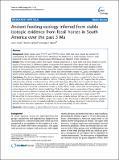Por favor, use este identificador para citar o enlazar a este item:
http://hdl.handle.net/10261/48939COMPARTIR / EXPORTAR:
 SHARE SHARE
 CORE
BASE CORE
BASE
|
|
| Visualizar otros formatos: MARC | Dublin Core | RDF | ORE | MODS | METS | DIDL | DATACITE | |

| Título: | Ancient feeding ecology inferred from stable isotopic evidence from fossil horses in South America over the past 3 Ma |
Autor: | Prado, José Luis; Sánchez Chillón, Begoña CSIC ORCID; Alberdi, María Teresa | Palabras clave: | Stable isotopes C4 plants Mammals Horses South America |
Fecha de publicación: | 14-jun-2011 | Editor: | BioMed Central | Citación: | BMC Ecology 11(1): 15 (2011) | Resumen: | [Background]: Stable isotope ratios (13C/12C and 18O/16O) in fossil teeth and bone provide key archives for understanding the ecology of extinct horses during the Plio-Pleistocene in South America; however, what happened in areas of sympatry between Equus (Amerhippus) and Hippidion is less understood. [Results]: Here, we use stable carbon and oxygen isotopes preserved in 67 fossil tooth and bone samples for seven species of horses from 25 different localities to document the magnitude of the dietary shifts of horses and ancient floral change during the Plio-Pleistocene. Dietary reconstructions inferred from stable isotopes of both genera of horses present in South America document dietary separation and environmental changes in ancient ecosystems, including C3/C4 transitions. Stable isotope data demonstrate changes in C4 grass consumption, inter-species dietary partitioning and variation in isotopic niche breadth of mixed feeders with latitudinal gradient. [Conclusions]: The data for Hippidion indicate a preference varying from C3 plants to mixed C3-C4 plants in their diet. Equus (Amerhippus) shows three different patterns of dietary partitioning Equus (A.) neogeus from the province of Buenos Aires indicate a preference for C3 plants in the diet. Equus (A.) andium from Ecuador and Equus (A.) insulatus from Bolivia show a preference for to a diet of mixed C3-C4 plants, while Equus (A.) santaeelenae from La Carolina (sea level of Ecuador) and Brazil are mostly C4 feeders. These results confirm that ancient feeding ecology cannot always be inferred from dental morphology. While the carbon isotope composition of horses skeletal material decreased as latitude increased, we found evidence of boundary between a mixed C3/C4 diet signal and a pure C4 signal around 32° S and a change from a mixed diet signal to an exclusively C3 signal around 35°S. We found that the horses living at high altitudes and at low to middle latitude still have a C4 component in their diet, except the specimens from 4000 m, which have a pure C3 diet. The change in altitudinal vegetation gradients during the Pleistocene is one of several possibilities to explain the C4 dietary component in horses living at high altitudes. Other alternative explanations imply that the horses fed partially at lower altitudes. |
Versión del editor: | http://dx.doi.org/10.1186/1472-6785-11-15 | URI: | http://hdl.handle.net/10261/48939 | DOI: | 10.1186/1472-6785-11-15 | E-ISSN: | 1472-6785 |
| Aparece en las colecciones: | (MNCN) Artículos |
Ficheros en este ítem:
| Fichero | Descripción | Tamaño | Formato | |
|---|---|---|---|---|
| 1472-6785-11-15.xml | 155,94 kB | XML | Visualizar/Abrir | |
| Alberdi BMC Ecology 2011 isotope horses SA.pdf | 1,41 MB | Adobe PDF |  Visualizar/Abrir |
CORE Recommender
PubMed Central
Citations
1
checked on 16-abr-2024
SCOPUSTM
Citations
33
checked on 16-abr-2024
Page view(s)
370
checked on 23-abr-2024
Download(s)
438
checked on 23-abr-2024
Google ScholarTM
Check
Altmetric
Altmetric
Artículos relacionados:
NOTA: Los ítems de Digital.CSIC están protegidos por copyright, con todos los derechos reservados, a menos que se indique lo contrario.
